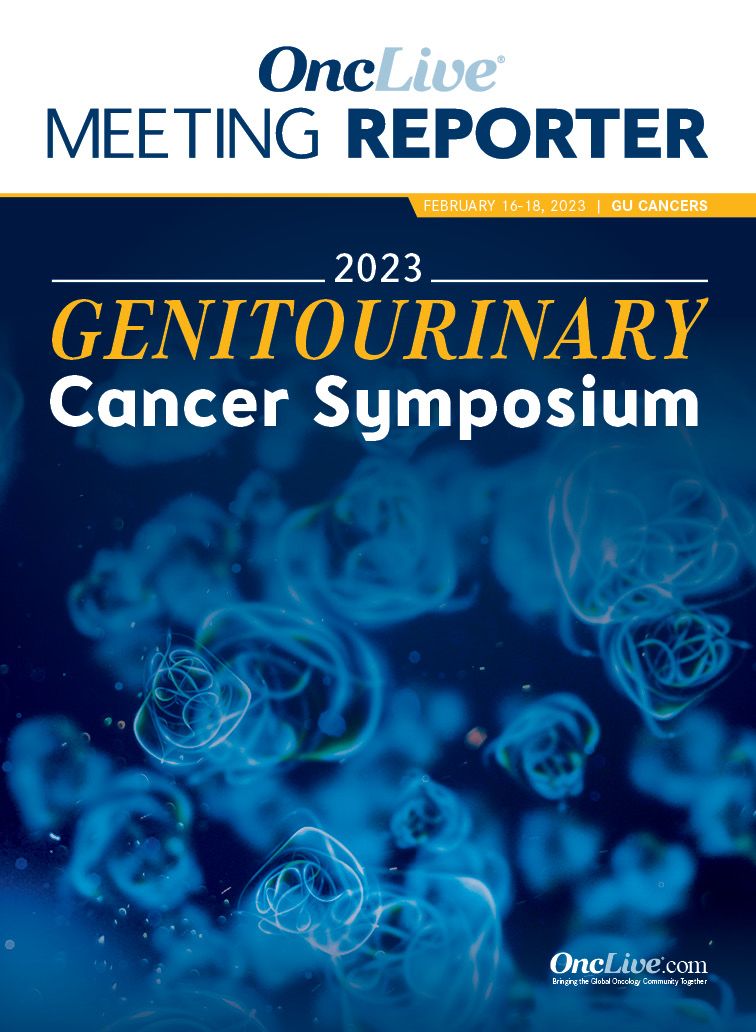Publication
Article
89Zr-DFO-girentuximab Showcases Sensitivity, Specificity for Clear Cell RCC Imaging
Author(s):
89Zr-DFO-girentuximab demonstrated sensitivity and specificity thresholds that were exceeded by 3 independent readers for PET/CT imaging of clear cell renal cell carcinoma, according to findings from the phase 3 ZIRCON study.
Brian M. Shuch, MD

89Zr-DFO-girentuximab demonstrated sensitivity and specificity thresholds that were exceeded by 3 independent readers for PET/CT imaging of clear cell renal cell carcinoma (RCC), according to findings from the phase 3 ZIRCON study (NCT03849118).1
The results, which were presented during the 2023 Genitourinary Cancers Symposium, showed that the sensitivity rate with 89Zr-DFO-girentuximab in the full analysis set was 85.5% (95% CI, 79.8%-89.8%) and the specificity rate was 87% (95% CI, 78.8%-92.3%). The positive predictive value was 93% (95% CI, 88%-96%), the negative predictive value was 75% (95% CI, 66%-82%), and the accuracy rate was 86% (95% CI, 81.5%-89.6%).
“ZIRCON is a pivotal phase 3 trial that basically shows that 89Zr-DFO-girentuximab met its end point. The floor of the sensitivity and specificity far exceeded what was defined as a positive trial,” lead study author Brian M. Shuch, MD, director of the Kidney Cancer Program and the Alvin and Carrie Meinhardt Endowed Chair in Kidney Cancer Research at University of California, Los Angeles Health, said in a presentation during the meeting. “I clearly think that this agent improves the identification of clear cell kidney cancer compared with any metric on any cross-sectional imaging study to date.”
Shuch noted that there is an unmet need for noninvasive characterization of indeterminant renal masses. Currently, anatomic imaging is unable to reliably distinguish between benign and malignant renal masses. Furthermore, renal mass biopsy is invasive, performed infrequently, and is often non-diagnostic. Approximately 20% to 30% of resected small renal masses are determined to be benign.
“I don’t know about you, but I’m tired of removing benign tumors,” Shuch said. “Having an accurate, noninvasive method that helps pretreatment risk stratification would really change the field, akin to what prostate-specific membrane antigen can do with prostate cancer.”
Carbonic anhydrase IX (CAIX) is a cell surface, transmembrane protein that is induced by hypoxia and is minimally expressed in normal tissue. Through hypoxia or von Hippel-Lindau loss, CAIX is upregulated, which may lead to acidification of extracellular pH, loss of cellular adhesion, and increased tumor cell migration.
Girentuximab is an IgG1 kappa light chain chimeric monoclonal antibody that binds with high specificity to CAIX and is internalized. Its hepatobiliary excretion allows for optimal renal visualization. The agent also has extensive safety experience in prior imaging and therapeutic studies.
89Zr, the payload, is a positron emitter hepatically cleared and suited for antibody-based imaging.
In previous studies, 89Zr-DFO-girentuximab demonstrated feasibility imaging in CAIX-positive tumors in the SPECT2 and PET3 studies.
In ZIRCON, 89Zr-DFO-girentuximab was administered at 37 MBq [1 mCi]/10 mg on day 0 to an adapted sample size of 300 patients between August 2019 and August 2022 across 36 sites and 9 countries. Patients underwent abdominal PET/CT imaging under blinded central image review that was performed 5+2 days post-administration. A partial/radical nephrectomy with central histology review was performed within 90 days of receiving 89Zr-DFO-girentuximab.
To be eligible to enroll on ZIRCON, patients had to have a single indeterminate renal mass 7 cm or smaller in diameter (cT1) on CT or MRI that was suspicious for clear cell RCC and scheduled for surgical removal.
The co-primary end points were sensitivity and specificity of 89Zr-DFO-girentuximab vs central histology, or surgical resection, in the detection of clear cell RCC. Key secondary end points were sensitivity and specificity of 89Zr-DFO-girentuximab in a cT1a (≤4 cm) subgroup.
Three hundred and seventy-one patients were screened, 332 were enrolled, and 300 patients comprised the safety analysis set with 284 in the full analysis set. A total 8.3% of patients withdrew early due to safety reasons/adverse effects (AEs; n = 2), loss to follow-up (n = 6), withdrawn consent (n = 5), or other (n = 12).
Within the safety analysis set, the median age was 62 years (range, 27-87) and 71.3% of patients were male. In the evaluable surgical samples (n = 288), the median lesion size was 3.7 cm (range, 0.9-7.7); 62% were cT1a (≤4 cm) lesions and 38% were cT1b lesions (≥4 to ≤7 cm). A total 13.5% of lesions were 2 cm or smaller.
Sixty-seven percent of patients had clear cell RCC; other renal lesions (33%) included papillary RCC (15.3%), chromophobe RCC (8%), oncocytoma (3%), spindle cell (1.4%), sarcoma (<1%), and other (5%).
In the cT1a lesions (n = 179), clear cell RCC was found in 65% of cases vs other renal lesions (35%). In comparison with cT1b lesions (n = 109), ccRCC comprised 71% of cases vs 39% of other renal lesions.
Additional data with the full analysis set showed that the sensitivity rates in readers 1, 2, and 3 were 84.13%, 85.19%, 87.30%, respectively; the specificity rates were 88.42%, 88.42%, and 84.21%, respectively. The positive predictive value was 93.53% in reader 1, 93.60% in reader 2, and 91.67% in reader 3; the negative predictive values were 73.68%, 75.00%, and 76.92%, respectively. The accuracy rates were 85.56%, 86.27%, and 86.27%, respectively.
When evaluating outcomes in the cT1a subgroup (n = 179), the sensitivity and specificity thresholds were also exceeded by all 3 independent readers. Data showed that the sensitivity rate was 85.5% (95% CI, 77%-91.2%) and the specificity rate was 89.5% (95% CI, 78.6%-95.2%); the positive and negative predictive values were 93.4% (95% CI, 86.1%-97%) and 78% (95% CI, 66.2%-86.5%), respectively. The accuracy rate was 87% (95% CI, 80.6%-91.4%).
Regarding safety, minimal AEs were linked with 89Zr-DFO-girentuximab; no unexpected safety signals were observed, and 18 patients (6%) had a grade 3 or higher treatment-emergent AEs. Shuch noted that the AE patterns were consistent with post-resection complications related to nephrectomy.
Editor’s Note: Dr Shuch disclosed honoraria from Exelixis, as well as consulting or advisory roles with Bristol-Myers Squibb, Genentech/Roche, Histosonics, Johnson & Johnson/Janssen, Merck, and Veracyte.
Reference
- Shuch BM, Pantuck AJ, Bernhard J-C, et al. Results from phase 3 study of 89Zr-DFO-girentuximab for PET/CT imaging of clear cell renal cell carcinoma (ZIRCON). J Clin Oncol. 2023;41(suppl 6; abstr LBA602). doi:10.1200/JCO.2023.41.6_suppl.LBA602
- Oosterwijk-Wakka JC, Boerman OC, Mulders PFA, et al. Application of monoclonal antibody G250 recognizing carbonic anhydrase IX in renal cell carcinoma.Int J Mol Sci. 2013;14(6):11402-11423. doi:10.3390/ijms140611402
- Kulterer OC, Pfaff S, Wadsak W, et al. A microdosing study with 99mTc-PHC-102 for the SPECT/CT imaging of primary and metastatic lesions in renal cell carcinoma patients. J Nucl Med. 2021;62(3):360-365. doi:10.2967/jnumed.120.245530










